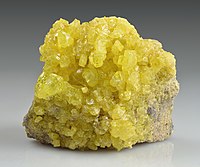
Photo from wikipedia
Cereal grains and tubers are among the highly consumed staple foods globally; however, due to unfavorable weather conditions and the competition for natural resources, the major staple cereal crops, such… Click to show full abstract
Cereal grains and tubers are among the highly consumed staple foods globally; however, due to unfavorable weather conditions and the competition for natural resources, the major staple cereal crops, such as rice, are under production threat. On the other hand, the overuse of chemical fertilizers and pesticides to increase crop yield is deteriorating the growing environment for plants and animals, including humans. As such, sustainable management practices are the key method that can be employed to increase crop production without harming the environment. Plant growth-promoting bacteria (PGPB), such as the purple non-sulfur bacteria (PNSB), have recently gained much attention in crop production due to their ability to accumulate higher-value compounds that are highly beneficial to crops. Some of the major benefits PNSB holds are that it can fix atmospheric nitrogen, solubilize phosphate, remediate heavy metals, suppress methane emissions from waterlogged paddy fields, and assist in carbon sequestration. These benefits allow PNSB to be an important bacterium for improving plant growth and yield much more sustainably while benefiting the environment. This review article discusses the beneficial effects of PNSB on rice crop plants through careful screening of previous work in this area. The review also identifies the research gaps and suggests future research pathways to make PNSB an important bacteria for sustainable rice crop production. The review paper aims for the United Nation’s sustainable development goal number two, “Zero Hunger,” target 2.4, indicator 2.4.1, “Proportion of agricultural area under productive and sustainable agriculture”.
Journal Title: Agronomy
Year Published: 2022
Link to full text (if available)
Share on Social Media: Sign Up to like & get
recommendations!